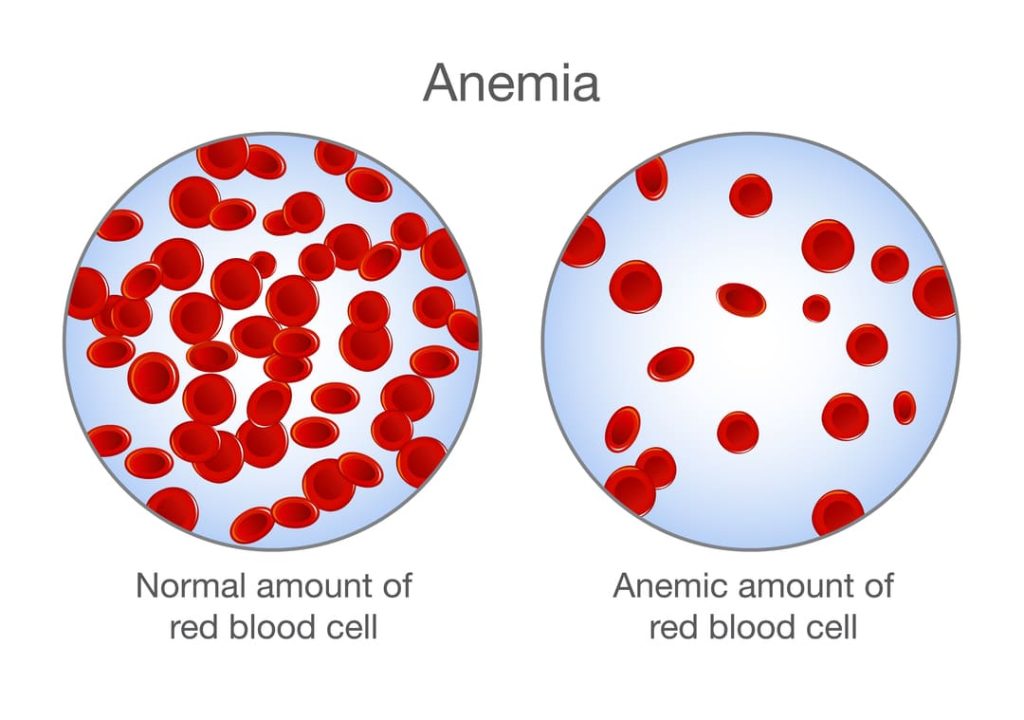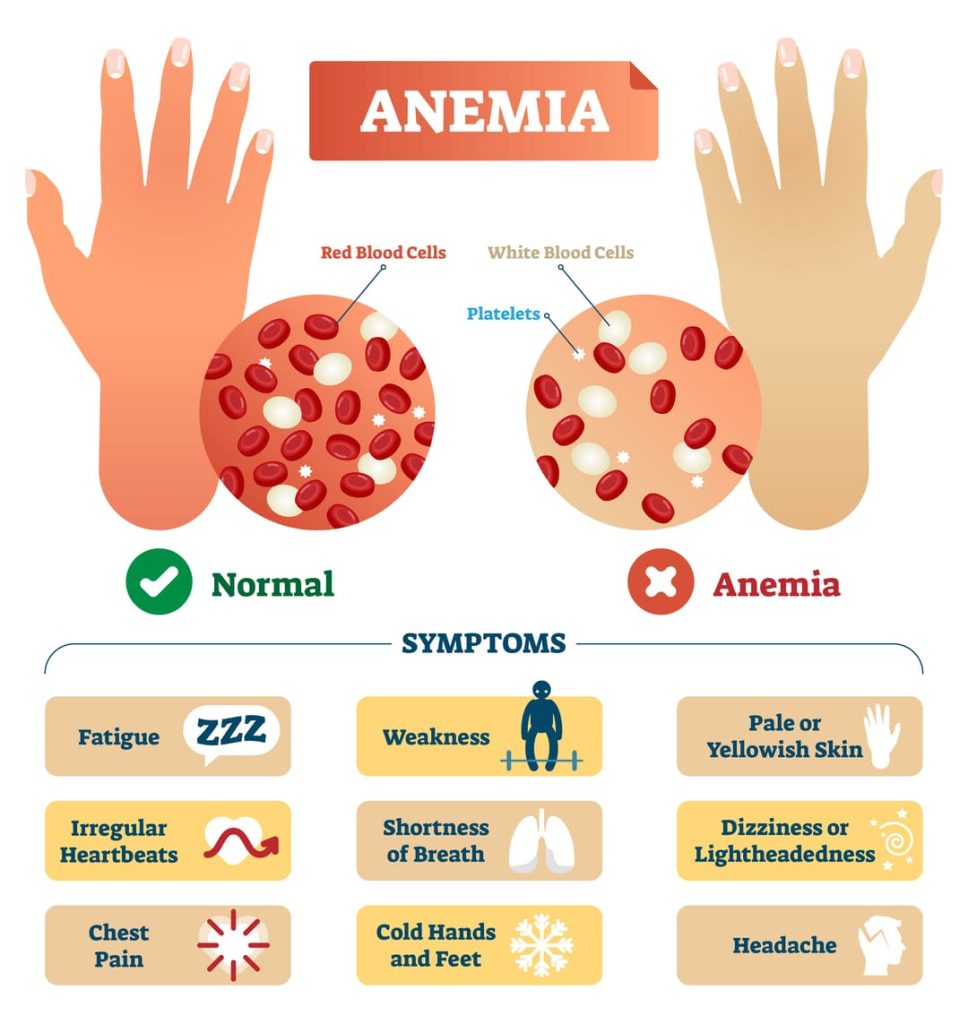Looking for Expert-Level VA Claim Answers?📱Call Us Now! 737-295-2226
Do you qualify for a VA rating for anemia?
If you’re struggling with anemia, you understand it can zap your energy and make it difficult to complete even basic tasks. You may also wonder if you qualify for an anemia VA rating.
This guide to VA disability for anemia explains how the VA rates anemia, how to file a VA claim for anemia to get service-connected, and more!
Let’s begin.
- What is Anemia?
- VA Rating for Anemia Explained
- What is the VA Disability Rating for Anemia?
- How to Get Service Connected for Anemia
- Anemia as a Presumptive Condition
- Qualifying for an Anemia VA Disability Rating
- Types of Amenia
- Symptoms of Anemia
- What Type of Anemia Is Associated With Chronic Kidney Disease?
- Getting Help with Your Anemia VA Disability Claim
- About VA Claims Insider
- NEED MORE ASSISTANCE?

What is Anemia?
Anemia is a condition with insufficient healthy red blood cells to carry adequate oxygen to the body’s tissues. The most common symptoms of anemia are fatigue and weakness, but you may also experience shortness of breath, lightheadedness, or dizziness.
There are several types of anemia, including Sickle Cell Anemia, Aplastic Anemia, Iron Deficiency Anemia, Pernicious Anemia, and Vitamin B12 Deficiency Anemia, Acquired Hemolytic Anemia, and Folic Acid Deficiency Anemia. Each type of anemia has its cause and treatment options.

You DESERVE a HIGHER VA rating.
Take advantage of a VA Claim Discovery Call with an experienced Team Member. Learn what you’ve been missing so you can FINALLY get the disability rating and compensation you’ve earned for your service.
VA Rating for Anemia Explained
Anemia VA disability ratings are available to veterans who are service-connected. To be service-connected, you must also show that your anemia began during active military service or was aggravated by military service.
If your anemia is caused or aggravated by another service-connected illness, it could also be service-connected on a secondary basis.
Anemia can be caused by many conditions, including folic acid deficiency, central nervous system impairment, and gastrointestinal disorders.

What is the VA Disability Rating for Anemia?
Anemia can be rated at 0%, 10%, 30%, 60%, or 100%, depending on your type of anemia and the severity of your symptoms. There are several types of anemia, and the anemia VA rating for each type depends on the severity of your condition. Each type of anemia has its own diagnostic code (DC).
Sickle Cell Anemia (DC 7714) is rated at 10%, 30%, 60%, or 100%, depending on the severity of the symptoms.
- 10% – The 10% rating is the least severe and is given to veterans who have entered remission and are asymptomatic but have sustained organ impairment.
- 30% – The 30% rating is for a veteran with one to two pain episodes within 12 months.
- 60% – The 60% rating is given if the veteran has three or more pain symptoms in a 12-month period or pain that prevents even light manual labor.
- 100% – The veteran must have at least four pain episodes within 12 months to be given a 100% rating. The pain must prevent light labor and can occur in major organs, skin, bones, and/or joints.
Aplastic anemia (DC 7716) is rated at 30%, 60%, or 100%.
- 30% – At the 30% rating level, you require an infusion of platelets or red blood cells or have an infection at least once in 12 months.
- 60% – At the 60% rating level, you require an infusion of platelets or red blood cells or have an infection at least once every 90 days for 12 months. You may also use continuous therapy with an immunosuppressant agent.
- 100% – At the 100% rating level, you require an infusion of platelets or red blood cells or have an infection at least once every six weeks over 12 months.
Iron deficiency anemia (DC 7720) is rated at 0%, 10%, or 30%.
- 0% – Asymptomatic or requiring treatment only by dietary modification
- 10% – Requiring intravenous iron infusions at least 1 time but less than 4 times per 12-month period or requiring continuous treatment with oral supplementation
- 30% – Requiring intravenous iron infusions 4 or more times per 12-month period
Pernicious anemia and Vitamin B12 deficiency anemia (DC 7722) are rated at 10% or 100%.
- 10% – If you require continuous treatment with vitamin B injections, vitamin B12 sublingual or high-dose oral tablets, or nasal spray, you may be eligible for a 10% disability rating.
- 100% – If your condition is more severe and you require a transfusion due to severe anemia or have central nervous system impairment, including peripheral neuropathy, myelopathy, or encephalopathy. In that case, you may be eligible for a 100% disability rating.
Acquired hemolytic anemia (DC 7723) is rated at 0%, 10%, 30%, 60%, or 100%, depending on the severity of the symptoms.
- 0% – Asymptomatic
- 10% – Requiring one course of immunosuppressive therapy per 12-month period
- 30% – Requiring at least 2 but less than 4 courses of immunosuppressive therapy per 12-month period
- 60% – Requiring immunosuppressive medication 4 or more times per 12-month period
- 100% – Requiring a bone marrow transplant or continuous intravenous or immunosuppressive therapy (e.g., prednisone, Cytoxan, azathioprine, or rituximab)
Folic acid deficiency anemia (DC 7721) is rated at 0% or 10%.
- 0% – If it doesn’t cause any symptoms or can be easily controlled by diet, then it is rated 0%.
- 10% – If it requires you to continuously take high doses of folic acid supplements, it is rated 10%.
If you are disabled by anemia, getting a formal evaluation from a VA-certified doctor is important to get the anemia VA disability rating you deserve.
How to Get Service Connected for Anemia
Veterans suffering from anemia because of their military service should know how to prove a service connection and file a VA disability claim.
To receive an anemia VA disability rating, you must meet the following requirements:
- A current medical diagnosis of anemia
- An in-service event, injury, illness, or aggravation
- A medical nexus (or link) between the current diagnosis and the in-service event, injury, or illness (can be a Nexus Letter)
Anemia as a Presumptive Condition
Anemia is also recognized by the VA as a presumptive condition for qualifying veterans. In this case, VA “presumes” the condition to be service-connected, even if there’s no specific Nexus (meaning “link” or “connection”) for service connection.
Once service connection is established, the VA will evaluate your anemia severity using the anemia VA disability rating criteria for your type of anemia. If you are found to be disabled by your anemia, you may be entitled to receive VA benefits for anemia (including VA monthly compensation and benefits).
Qualifying for an Anemia VA Disability Rating
To qualify for an anemia VA rating, veterans must provide evidence of how the condition has impacted their ability to work or live a normal life. In most cases, this will involve documenting symptoms such as fatigue, lightheadedness, and shortness of breath.
Veterans who provide this evidence may qualify for a partial or total VA disability for anemia. Your anemia VA rating will depend on the severity of the condition and your ability to work.

Types of Amenia
Sickle Cell Anemia
Sickle cell anemia is a disorder where the red blood cells that carry the oxygen become shaped like a sickle (or a boomerang). Because of this, they are not able to carry as much oxygen to the body, and they sometimes get stuck in small blood vessels, blocking the blood flow to the tissues. In many cases, this disease is present from birth and has no known cure.
Symptoms of sickle cell anemia include fatigue, shortness of breath, and pain.
Aplastic anemia
Aplastic anemia can be a life-threatening condition that occurs when your body doesn’t produce enough red blood cells. Red blood cells are responsible for carrying oxygen from your lungs to the rest of your body. Without enough red blood cells, your organs and tissues can’t get the oxygen they need to function properly.
Aplastic anemia can be difficult to diagnose, as the symptoms are often nonspecific. However, it is important to seek medical attention if you experience any of the following: fatigue that is severe or unexplained; shortness of breath; pallor; easy bruising or bleeding; or frequent infections.
Aplastic anemia can be caused by various factors, including certain medications, infections, and autoimmune diseases. Treatment for aplastic anemia typically includes blood transfusions and immune suppression therapy. In some cases, a bone marrow transplant may be necessary. Most people with aplastic anemia can lead active, productive lives with treatment.
Iron Deficiency Anemia
Iron deficiency anemia is a type of anemia caused by low levels of iron in the blood. Some causes include a lack of iron in your diet or blood loss.
To evaluate iron deficiency anemia can be tricky because the symptoms can be nonspecific. However, there are some key signs that doctors look for. The most common symptom of this condition is fatigue, which can make it difficult to perform everyday tasks. In addition, iron deficiency anemia can also cause pale skin, cold hands, and feet, shortness of breath, dizziness, and headache.
If left untreated, iron deficiency anemia can lead to serious health problems such as heart failure and stroke.
Pernicious Anemia and Vitamin B12 Deficiency Anemia
Pernicious anemia and vitamin B12 deficiency anemia are two types of anemia that vitamin deficiencies can cause.
Pernicious anemia is a type of anemia that occurs when the stomach lining is unable to absorb vitamin B12. Vitamin B12 is necessary to produce red blood cells so a deficiency can lead to anemia. Pernicious anemia is more common in older adults and can be treated with vitamin B12 injections or supplements.
Vitamin B12 deficiency anemia can also occur when there is a lack of vitamin B12 in the diet. This type of anemia is most common in vegetarians or vegans who do not eat foods that contain vitamin B12, such as meat, poultry, eggs, or dairy products. Vitamin B12 deficiency anemia can also occur in people with pernicious anemia or other conditions that make it difficult to absorb vitamin B12 from food. Treatment for this type of anemia typically includes taking oral vitamin B12 supplements or receiving injections of vitamin B12.
Acquired Hemolytic Anemia
Acquired hemolytic anemia is a type of anemia that can develop in response to a disease or exposure to certain medications. The most common symptoms of acquired hemolytic anemia are fatigue, shortness of breath, and pale skin.
This type of anemia can be particularly dangerous for veterans, leading to a weakened immune system and increased susceptibility to infections.
Folic Acid Deficiency Anemia
This type of anemia is caused by low levels of folic acid in the blood. Folic acid is a B vitamin that helps your body make red blood cells. If you don’t have enough red blood cells, you have anemia.

Symptoms of Anemia
Anemia can be caused by various factors, including blood loss, dietary deficiencies, and certain medical conditions.
While some people have no symptoms, others may experience chest pain, cold hands and feet, dizziness or lightheadedness, headaches, irregular heartbeat, shortness of breath, and yellow or pale skin.
What Type of Anemia Is Associated With Chronic Kidney Disease?
There are various types of anemia, each with its underlying cause. Anemia associated with chronic kidney disease (CKD) is typically caused by a combination of factors, including decreased production of erythropoietin (a hormone that regulates red blood cell production) and iron deficiency.
In CKD patients, these factors can decrease the number of healthy red blood cells, resulting in anemia. Symptoms of CKD-related anemia may include fatigue, shortness of breath, and lightheadedness.
If left untreated, anemia can lead to serious complications like heart problems and organ failure. While there is no cure for CKD, early diagnosis and treatment of anemia can help to improve symptoms and prevent complications.
Getting Help with Your Anemia VA Disability Claim
At VA Claims Insider, we’re here to walk you through everything you need to know, including how to file your VA claims. We hope this guide has been helpful. Remember, if you have any questions, we encourage you to contact us for support.
About VA Claims Insider
- VA Claims Insider is a highly rated, veteran-owned and operated business.
- 25,000+ disabled veterans served in our membership programs since 2016.
- 30% average VA rating increase for veterans who complete our #1 rated Elite program.
- Employs 175 teammates; comprised of 55 veterans and 12 military spouses.
- 4.7/5.0 average rating out of 4,000+ total reviews; over 3,000 5-star reviews.

NEED MORE ASSISTANCE?
Most veterans are underrated for their disabilities and therefore not getting the compensation they’re due. At VA Claims Insider, we help you understand and take control of the claims process, so you can get the rating and compensation you’re owed by law. Our process takes the guesswork out of filing a VA disability claim and supports you every step of the way in building a fully-developed claim (FDC)—so you can increase your rating FAST!
If you’ve filed your VA disability claim and have been denied or have received a low rating—or you’re unsure how to get started—reach out to us! Take advantage of a FREE VA Claim Discovery Call. Learn what you’ve been missing—so you can FINALLY get the disability rating and compensation YOU DESERVE!



